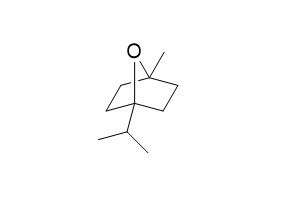1,4-Cineole
1,4-Cineole presents potential anxiolytic-like action consistent with possible general depression of the CNS.
Inquire / Order:
manager@chemfaces.com
Technical Inquiries:
service@chemfaces.com
Tel:
+86-27-84237783
Fax:
+86-27-84254680
Address:
1 Building, No. 83, CheCheng Rd., Wuhan Economic and Technological Development Zone, Wuhan, Hubei 430056, PRC
Providing storage is as stated on the product vial and the vial is kept tightly sealed, the product can be stored for up to
24 months(2-8C).
Wherever possible, you should prepare and use solutions on the same day. However, if you need to make up stock solutions in advance, we recommend that you store the solution as aliquots in tightly sealed vials at -20C. Generally, these will be useable for up to two weeks. Before use, and prior to opening the vial we recommend that you allow your product to equilibrate to room temperature for at least 1 hour.
Need more advice on solubility, usage and handling? Please email to: service@chemfaces.com
The packaging of the product may have turned upside down during transportation, resulting in the natural compounds adhering to the neck or cap of the vial. take the vial out of its packaging and gently shake to let the compounds fall to the bottom of the vial. for liquid products, centrifuge at 200-500 RPM to gather the liquid at the bottom of the vial. try to avoid loss or contamination during handling.
Academic J of Second Military Medical University2018, 39(11)
Pharmaceutics.2020, 12(9):882.
Appl. Sci.2023, 13(17):9984.
European Journal of Integrative Medicine2018, 20:165-172
Chinese Medicine2019, 14(1)
Cell Rep.2022, 39(1):110643.
Molecules.2020, 25(21):5087.
Int J Mol Sci.2024, 25(18):9909.
Appl. Sci.2021, 11(19),9343.
BMC Complement Altern Med.2019, 19(1):11
Related and Featured Products
Pharmacology Biochemistry and Behavior,2010,96(3):287-293.
Anxiolytic-like effect of the monoterpene 1,4-cineole in mice.[Reference:
WebLink]
Recent studies have shown that some monoterpenes exert anxiolytic- and depressant-like actions, however, these effects from monoterpene 1,4-Cineole are still unknown.
METHODS AND RESULTS:
This work aimed to study the effects of 1,4-Cineole in classic animal models for depression- and anxiety-like behavior, specifically the elevated plus maze (EPM), hole board, open field, pentobarbital sleeping time, forced swimming, tail suspension and rota rod tests. 1,4-Cineole was administered orally to mice (100, 200 and 400 mg/kg), while diazepam (1 or 2 mg/kg) and imipramine (10 or 30 mg/kg) were used as standard drugs. 1,4-Cineole (400 mg/kg) modified all parameters observed in the EPM, while no significant variation was observed on general motor activity in the open-field test. In the hole-board assay, 1,4-Cineole induced increase on the number of head dips. Forced swimming and tail suspension tests showed that cineole (200 and/or 400 mg/kg) was able to promote significant increase on the immobility time, while a decreased sleep latency was observed (200 and 400 mg/kg ) on the pentobarbital sleeping time. Cineole had no effect on the motor coordination of animals in the rota rod test.
CONCLUSIONS:
The results suggest that 1,4-Cineole presents potential anxiolytic-like action consistent with possible general depression of the CNS.
Journal of Essential Oil Research, 2001,13:37-42.
Essential Leaf Oil of Persea Subgenus Eriodaphne and Closely Related Perseoid Genera.[Reference:
WebLink]
METHODS AND RESULTS:
The leaf oils of Persea caerulea, P. cinerascens, P. donnell-smithii, P. lingue, P. longpipes, P. pachypoda, P. palustris, P. skutchii, Beilschmiedia miersii, B. tarairie, Litsea calicaris, Nectandra umbrosa, N. salicina, Ocotea Valeriana and O. bothrantha were analyzed by GC and GC/MS.
CONCLUSIONS:
The major components of the Persea oils were sabinene (20.1%) and β-caryophyllene (11.0%) in P. caerulea; α-phellandrene (24.9%) and α-terpinene (18.9%) in P. cinerascena; α-pinene (20.5%), β-pinene (16.9%) and germacrene D (24.3%) in P. donnell-smithii; sabinene (14.5%), β-carophyllene (11.3%), germacrene D (11.6%) and Γ-cadinene (18.6%) in P. lingue; β-caryophyllene (6.5%) and α-humulene ((7.3%) in P. longpipes; β-terpinene (12.6%) and camphor (29.3%) in P. pachypoda; 1,8-cineole (33.7%) and camphor (10.2%) in P. palustris and α-pinene (14.8%), 1,8-cineole (12.3%), Γ-terpinene (12.8%) and germacrene D (12.2%) in P. skutchii. The oils of Beilschmiedia miersii and B. tarairie were found to be rich in α-terpinene (10.0%) and germacrene D (24.8%), and α-pinene (17.8%) and germacrene D (6.6%), respectively. Litsea calicaris oil contained δ-cadinene (38.2%) and T-muurolol (28.7%) as main constituents. The main constituents of the oils of Nectandra umbrosa and N. salicina were methoxsalen (24.5% and 30.1%) and indene (14.7% and 22.5%), respectively.
The oils of Ocotea Valeriana and O. botrantha were found to be rich in 1,4-Cineole (19.6%) and (Z)-anethole (13.4%), and δ-elemene (11.2%), β-caryophyllene (13.4%) and germacrene D (35.2%), respectively.



